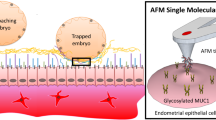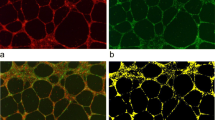Abstract
The complex implantation process is initiated by the recognition and adhesion between the embryo and uterine endometrial epithelium. The expression and interactions between the adhesive molecules from both fetal and maternal sides are crucial for the successful implantation. In this study, we aimed to investigate the expression and adhesive function of sLeX on the trophoblasts and L-selectin on uterine epithelial cells mediated the adhesion at the fetal–maternal interface, and to further explore whether this adhesion system could induce endometrial apoptosis, using in vitro implantation model consisting of the human trophoblast cell line (JAR) and human uterine epithelial cell line (RL95-2). The results showed that sLeX was expressed on JAR cells by indirect immunofluorescence staining. After transfection of JAR cells with fucosyltransferase VII (FUT7) which is the key enzyme for sLeX synthesis, the expression of FUT7 and sLeX synthesis were increased, and the percent adhesion of trophoblast cells to RL95-2 cell monolayer was significantly increased (P < 0.01). L-selectin was strongly expressed but not E- and P-selectin on epithelial RL95-2 cells by RT-PCR, Western blot. Blocking L-selectin with specific antibody or heparin pretreatment in RL95-2 cells inhibited the adhesion of JAR cells to RL95-2 cell monolayer. Furthermore, regulating the expression of sLeX on JAR cells or blocking L-selectin on RL95-2 cells could activate the apoptosis of uterine epithelial cells. These results suggest the sLeX/L-selectin adhesion system at fetal–maternal interface not only mediates the adhesion of embryo to uterine epithelium, but also effectively induces the apoptosis in uterine epithelium. The study supplies a molecular basis for the elucidation of the initial recognition and adhesion during embryo implantation.





Similar content being viewed by others
Abbreviations
- sLeX:
-
Sialyl Lewis X
- FUT7:
-
Fucosyltransferase VII
- SNARF-1:
-
5-Chloromethy carboxyseminapthorhodofluor-1
- DAPI:
-
4,6-Diamino-2-phenyl indole
- TRITC:
-
Tetramethylrhodamine isothiocyanate
- FITC:
-
Fluoresceinisothiocyanate
- HRP:
-
Horseradish peroxidase
- PE:
-
Phycoerythrin
- FBS:
-
Fetal bovine serum
- BSA:
-
Bovine serum albumin
- ECL:
-
Enhanced chemiluminescence
References
Guzeloglu-Kayisli O, Basar M, Arici A (2007) Basic aspects of implantation. Reprod Biomed Online 15:728–739
Makrigiannakis A, Minas V (2007) Mechanisms of implantation. Reprod Biomed Online 14:102–109
Aplin JD (1997) Adhesion molecules in implantation. Rev Reprod 2:84–93
Dey SK, Lim H, Das SK et al (2004) Molecular cues to implantation. Endocr Rev 25:341–373
Lai TH, Shih IeM, Vlahos N, Ho CL, Wallach E, Zhao Y (2005) Differential expression of L-selectin ligand in the endometrium during the menstrual cycle. Fertil Steril 83:1297–1302
Wang B, Sheng JZ, He RH, Qian YL, Jin F, Huang HF (2008) High expression of L-selectin ligand in secretory endometrium is associated with better endometrial receptivity and facilitates embryo implantation in human being. Am J Reprod Immunol 60:127–134
Läubli H, Stevenson JL, Varki A, Varki NM, Borsig L (2006) L-selectin facilitation of metastasis involves temporal induction of Fut7-dependent ligands at sites of tumor cell arrest. Cancer Res 66:1536–1542
Smith PL, Gersten KM, Petryniak B et al (1996) Expression of the alpha (1, 3) fucosyltransferase Fuc-TVII in lymphoid aggregate high endothelial venules correlates with expression of L-selectin ligands. J Biol Chem 271:8250–8259
Zhang Y, Liu S, Liu Y, Wang Z, Wang X, Yan Q (2009) Overexpression of fucosyltransferase VII (FUT7) promotes embryo adhesion and implantation. Fertil Steril 91:908–914
Liu S, Zhang Y, Liu Y, Qin H, Wang X, Yan Q (2008) FUT7 antisense sequence inhibits the expression of FUT7/sLeX and adhesion between embryonic and uterine cells. IUBMB Life 60:461–466
Uchimura K, Rosen SD (2006) Sulfated L-selectin ligands as a therapeutic target in chronic inflammation. Trends Immunol 27:559–565
Jackson LA, Drevets DA, Dong ZM, Greenfield RA, Murphy JW (2005) Levels of L-selectin (CD62L) on human leukocytes in disseminated cryptococcosis with and without associated HIV-1 infection. J Infect Dis 191:1361–1367
Kawashima H (2006) Roles of sulfated glycans in lymphocyte homing. Biol Pharm Bull 29:2343–2349
Resto VA, Burdick MM, Dagia NM, McCammon SD, Fennewald SM, Sackstein R (2008) L-selectin-mediated lymphocyte–cancer cell interactions under low fluid shear conditions. J Biol Chem 283:15816–15824
McEver RP (1997) Selectin–carbohydrate interactions during inflammation and metastasis. Glycoconj J 14:585–591
Genbacev OD, Prakobphol A, Foulk RA et al (2003) Trophoblast L-selectin-mediated adhesion at the maternal–fetal interface. Science 299:405–408
Fazleabas AT, Kim JJ (2003) What makes an embryo stick? Science 299:355–356
Galan A, O’Connor JE, Valbuena D et al (2000) The human blastocyst regulates endometrial epithelial apoptosis in embryonic adhesion. Biol Reprod 63:430–439
Thie M, Denker HW (2002) In vitro studies on endometrial adhesiveness for trophoblast: cellular dynamics in uterine epithelial cells. Cells Tissues Organs 172:237–252
Tinel H, Denker HW, Thie M (2000) Calcium influx in human uterine epithelial RL95-2 cells triggers adhesiveness for trophoblast-like cells. Model studies on signalling events during embryo implantation. Mol Hum Reprod 6:1119–1130
Nelson SM, Greer IA (2008) The potential role of heparin in assisted conception. Hum Reprod Update 14:623–645
Stevenson JL, Varki A, Borsig L (2007) Heparin attenuates metastasis mainly due to inhibition of P- and L-selectin, but non-anticoagulant heparins can have additional effects. Thromb Res 120:107–111
Abrahams VM, Straszewski-Chavez SL, Guller S, Mor G (2004) First trimester trophoblast cells secrete Fas ligand which induces immune cell apoptosis. Mol Hum Reprod 10:55–63
Staun RE, Shalev E (2005) Human trophoblast function during the implantation process. Reprod Biol Endocrinol 20:56
Achache H, Revel A (2006) Endometrial receptivity markers, the journey to successful embryo implantation. Hum Reprod Update 12:731–746
Carson DD (2002) The glycobiology of implantation. Front Biosci 1:1535–1544
Wang XQ, Zhu ZM (1998) Role for cell surface oligosaccharide in cell-cell recognition during implantation. Mol Hum Reprod 4:735–738
Shamonki MI, Kligman I, Shamonki JM (2006) Immunohistochemical expression of endometrial L-selectin ligand is higher in donor egg recipients with embryonic implantation. Fertil Steril 86:1365–1375
Prakobphol A, Genbacev O, Gormley M, Kapidzic M, Fisher SJ (2006) A role for the L-selectin adhesion system in mediating cytotrophoblast emigration from the placenta. Dev Biol 298:107–117
Becker DJ, Lowe JB (2003) Fucose: biosynthesis and biological function in mammals. Glycobiology 13:41–53
Taniguchi N, Honke K, Fukuda M (2002) Handbook of glycosyltransferases and related genes. In: Oriol R, Mollicone R, Narimatsu H (eds) Fucosyltransferases. Springer, Tokyo, pp 205–231
Zhang Q, Liu S, Zhu Z, Yan Q (2009) Regulating effect of LIF on the expression of FuT7: probe into the mechanism of sLe(x) in implantation. Mol Reprod Dev 76(8):692
Acknowledgments
This work is supported by National Natural Science Foundation of China Research Grant (30670465), Specialized Research Fund for the Doctoral Program of Higher Education of China (20060161001), and Fund for Creative Research Groups of Liaoning Province (2007T021).
Author information
Authors and Affiliations
Corresponding author
Rights and permissions
About this article
Cite this article
Liu, S., Yang, X., Liu, Y. et al. sLeX/L-selectin mediates adhesion in vitro implantation model. Mol Cell Biochem 350, 185–192 (2011). https://doi.org/10.1007/s11010-010-0697-x
Received:
Accepted:
Published:
Issue Date:
DOI: https://doi.org/10.1007/s11010-010-0697-x




